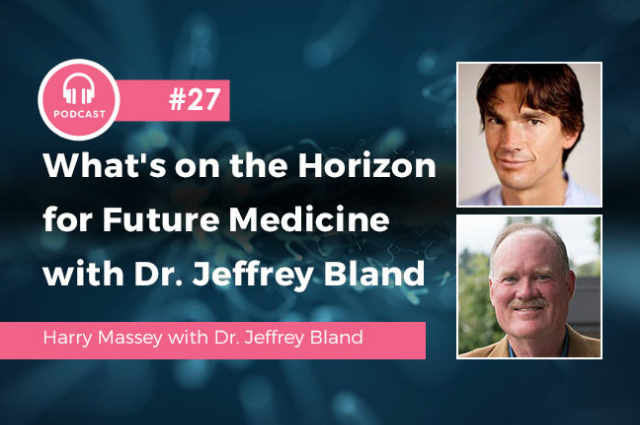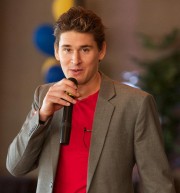Listen
Listen to this podcast or watch the video. CLICK HERE
Transcript
00:01:00 Meeting Dr. Jeffrey Bland
00:03:25 Where is healthcare going?
00:04:40 What is energy medicine?
00:07:30 What’s the most efficient field-based communication system?
00:11:35 Explaining the existence of the body-field and how it works
00:13:40 How does light work in humans and animals?
00:15:45 Evidence that we are energy beings
00:17:25 Body-field breakthrough as important as decoding the human genome
Harry Massey: Welcome to the Supercharged Podcast, where we help you to enhance your energy, health, and purpose.
Wendy Myers: Bioenergetics is truly the future of medicine.
Harry: Imagine having a body charged with energy and a mind quick as lightning. Is that a superhero? No, that’s you, supercharged. We’ll be talking to experts who have studied the physics of life so that you can have energy for life. It’s pretty clear that the current medical system needs a fundamental shift or even a quantum leap in new methodologies. Now, the current paradigm it isn’t giving many of us the solutions we need. In fact, a lot of it is contributing to more problems. So what exactly is on the horizon for the future of medicine. Now,
[00:01:00] that’s the subject of this podcast and have a very special guest view with some fascinating insights. Dr. Jeffrey Bland. Now, Dr. Jeffrey Bland is a pioneer and functional medicine. He’s the founder and senior ever auditors, board member of the Institute for functional medicine, which was founded in 19 one and is focused on educating healthcare practitioners on effective approaches to treating and preventing chronic disease. Now, who is our functional medicine really helpful, it’s what’s helped get me on this path. And so when I asked a functional medicine doctor in England, all those years ago, 15 years ago, I think now 16 years ago for a recommendation in energy medicine. He was the person who introduced me to Professor Peter Fraser. Now, Dr. Bland, he’s also a president of the person is a lifestyle Medicine Institute in Seattle. He’s offered five books on nutritional medicine, and six books and other six books on nutrition and health for the general public and the other ones, rule healthcare professionals. And he was also the first member of the Board of Trustees of baster University in Washington state, which is the first federally accredited university in the United States offering degrees in natural medicine. So he’s a pioneer of pioneers. Now, as Dr. Bland is such pioneer and change maker in the natural health sciences, and committed to advancing education. This field, I absolutely jumped at the chance to meet him. This episode was recorded when we were both for the consumer health summit in Phoenix. And well, where do we start. So chronic disease is on the rise worldwide. And while discoveries in genomics and medical technologies are advancing rapidly, medicine is poised for change in the 21st century. And as Dr. ban is just about to cover, this is driven by a movement of informed and motivated consumers and all in all, personalized healthcare. Alongside that, we obviously have a lot of new research discoveries and new tech technologies. And as you know, by Jessica is at the forefront of energy medicine. And it really is the next evolution beyond a functional medicine. And what we’re about is all about revolutionizing healthcare to make it simpler and more effective. So I was really pleasure and interest here with Jeff has to say about the future of medicine. So here we go. So I kicked off by asking adoptable and just where is healthcare going, what are the main trends that you see happening.
Jeffrey Bland: I think if you hear a medicine is really defining itself now pretty clearly that for the first time, we’re really starting to develop a technology to be able to
[00:03:25] individualize medicine to the person, this whole concept of personalization. And so we’re, we’re really seeing a transition from medicine to the average, which is a way that it’s been treated to medicine to the individual. And that will be powered by all sorts of new technologies, including the omics technologies, and big data management and new ways of looking at function using biometrics and wearable devices, and, and really ways of having real time 24 hour information that we would all carry with us in the cloud that is going to produce an information database about things that influence our function in ways that we never had access before. So it’s really going to be a revolutionary time to a patient centered healthcare system.
Harry: The big part of the revolution in patient centered healthcare involves energy medicine, which bioenergetics and NES Health is all about, but the concept of
[00:04:40] energy medicine can often get misunderstood. So what is energy medicine? And how do we know that the body produces energy?
Jeffrey: You know, energy and medicine is a very interesting topic. I don’t think any physician, if they’re thoughtful about their art, would disagree that the body produces energy, we all know metabolically, we take food in, and we convert it into packets of energy biochemically that we use to do everything from muscle contraction, reproduction, healing movement, and so forth. But where probably it’s become less well understood. And this is changing, is how energy travels through the body. And the body is an electromagnetic oscillator that produces its own bioelectric field, admittedly, a fairly low field strength, but we are an electric being, and I think this is a consequence, actually having better understanding of where the energy powerhouse of the cells reside, which are called the mitochondria, these organelles that reside in cells that you really take energy from food and convert it into metabolic energy. And that’s these are really a little packets of function that create their own electric field. And it’s like a little electric generators. So our body is really a very profoundly modulated electrical device that travels not just through the nervous system, which we’re pretty well aware of the bioelectric nature of nerve transmission. But it also travels through cells that influence intracellular contact, intracellular communication, things that really relate to functional aspect of the body. So that means that certain wavelengths of light certain packets, certain wavelengths of bioelectric energy could in fact influence then the way that cells are resonating and create then a different kind of physiological outcome. And we know this is true, because if you take animals and you put them in a very high magnetic field two or three Tesla magnetic field, you’ll find that their mitochondrial bioenergetics changes. So we know that we have an interrelationship between electromagnetic fields that are the right wavelength and frequency that influenced in our bodies function. So this is well understood at a fundamental level of physiology. The question is, how does that then translate into ways that we can make measure it and then use it as a tool for treatment.
Harry: So one tool in bioenergetics involves providing the field with new patterns of energy, and then those patterns of energy get to talk to the cells. So how are
[00:07:30] cells able to communicate and taking into account how light works in the body in Dr. Bland’s view, is there a field based communication system that would be more efficient than a biochemical based system? So very critical point.
Jeffrey: Yeah, I think that when you examine really at the fundamental level, what we’ve learned about how one cell talks to another, sometimes at a distance across the whole body from one organ to another organ, what we find that there are really three principal mechanisms. But I think by which occurs, one of which is related to bio molecules that are secreted in traveling the bladder, across tissues and so called autocrine effects of influence adjacent cells. That would be one very obvious mechanism that is called intracellular communication. Another is by bioelectric activity, through the nervous system and ether, ether, and different nerves that transmit electrical in your energy that empower cells to do certain things. And the third is, is mechanical, you know, for instance, we know that exercise or trauma can have a direct influence on cellular function through a mechanical receptor system, that’s another form of energy that gets communicated from a cell, to cell. So I think that as we examine each of these ways that cells interact one with the other, we start to see a few… we know quite a bit about the biochemical communication pathways who are hormones and messenger molecules and neurotransmitters and so forth. Weknow increasing amounts of barrel receptor is the mechanical types of processes. And we’re just starting now to learn much more about how to harness these these electrical inputs beyond that of the nervous system itself. And I’m always amazed when I think of things like NMR and various types of scanning technologies that are really built around understanding energetics of cells and how they resonate. Probably the person that I have learned the most about that is Dr. Leroy Hood, who has been credited as being kind of the father of the concept of systems biology. He was a Caltech professor for many years, and had a huge impact upon discovering aspects of the immune system. And one of the things that Dr. Hood came to recognize was that you could only understand the immune system if, if you looked at both its biology and the physics of the body simultaneously. And so he was the first person that I know of, in academic research based medicine that tried to cross boundaries, and went to the dean at Caltech dean of sciences and said, We need to form a department that brings physics and chemistry and biology together a vital Physical Chemistry Department in which we break down these barriers because we’re really talking about processes that interrelate to control function, which in this case, he was trying to examine the immune system. And there was a big push back at Caltech to do that saying, Oh, no, each one of these disciplines wants to stay in their own comfort zone. And they have their own language and their own meetings in their own, you know, kind of formalism. But he was absolutely undaunted. And as a consequence of doing extraordinary science and being very successful and getting philanthropic and NIH grant money was ultimately able to form the first department of biophysical Sciences at Caltech as far as I know, that spawned in a whole new revolution, that we’re really starting to see physical biochemistry marrying itself into medicine. And so we’re really I think, witnessing a kind of a new age scientists clinician that is, is exploiting and utilizing concepts of physics, along with the applications to biology, understanding how that connects to biochemistry. And then lastly, the most important fourth point is they’re really intelligent about how to capture that data and informatics systems. So you can examine this this very complex data set in ways that we couldn’t do before. So it’s the marriage of those four things together only recently that I think it started to allow us to examine biophysical function.
Harry: So there is a need for both biochemistry and physics to merge and for that
[00:11:35] information to flow, but what about information flow in the body? Now we have a master control system, a body-field, which is perceived as energy, but really within that there are patterns of energy, how do you explain the existence of our body-field and how it works?
Jeffrey: Well, I think anytime you have organized structure, you have information, that’s what information is it organized structure, and it can be encoded in many different things. It can be coated in one and zeros in the binary codes that underpin computers, code or can be encoded in complex structures that give rise to a certain times a resonant frequencies that allows us to do things like identify molecules using different resonance spectroscopy. So I think that the construct that we have in a complex body different organizational structure, is it have information encoded within their physical chemistry is absolutely correct. There’s no doubt about it. And the question is, how do we then interrogate that and then how can it be useful in guiding individual treatment? The process of photosynthesis is Einstein board quantum process. I mean, if you want to think of the application of quantum chemistry to biology, or quantum physics to biology, that’s a classic example. You know, people say, Oh, yeah, well, we observe a photon and say, the green pigment that’s magnesium containing chlorophyll translates that then through energy field that then ultimately fixes carbon dioxide into protoplasm, as, you know, sounds really easy to explain. But when it really gets down to the fundamental understanding of how that occurs, it’s a very, very complex photo electric effect that was described by Einstein, you know, in the early days of the
[00:13:40] development of quantum theory. So I think that you can only understand things like that by enlisting a different type of physics and different types of science, then you would to look at the macro molecular functions.
Harry: So when we’re looking at photosynthesis, working in plants, well, does this happen in our own biology? How does light actually work in animals and humans?
Jeffrey: Yeah, I think that the concept of light in his interaction with living systems is still in an extraordinary robust area of growth of understanding. I mean, we have simple examples like melanin, obviously, with tanning. And we’ve got things like melatonin with the pineal gland it’s released upon exposure, of the eye to near UV radiation near UV light. So we know certain things we know about vitamin D photo chemistry as well that converts the deoxycholesterol into colleague called referral. All of these are examples of how light serves as a biological force that influences function, what we’re starting to learn more of our some of the other components of what we call the electromagnetic spectrum that are outside the visible spectrum. So they don’t fall within the red to violet range. And how do those that influence other functional capacities, because there are many different molecules in our body that absorb electromagnetic energy outside the visible spectrum. And we haven’t really studied that much, because it’s easier to look at things that are colored because our eyes can see colors than things that are not colored, in which the radiation is in influencing out of the visual area of color. So I think that we’re really starting to see much more understanding now of, of how the edges, the, the near infrared, or the, the near UV, how those then influence things. And then we go out even longer and longer wavelengths, then in the, you know, microwaves and ultimately into radio waves, and the shorter wavelengths,
[00:15:45] how things like x rays, and in cosmic rays, and all those things influence various functions. This is a huge treasure trove of new opportunity for discovery.
Harry: So if the body is missing all these different forms of energy, all at different frequency ranges from the sound and voice fans down to photon emissions around our fingers. Is that a large part of explaining that we are energy beings?
Jeffrey: Yeah, I think that the construct of sound is a very interesting example of how
energy that’s encoded within information of packets in this case of waves of air impinging upon the tympanic membrane of our inner ear can be translated into coherence of decision making. And if you think about that for a second, it is really quite an amazing concept that a person pushing air like I’m doing right now, as I’m speaking, can then impinge on another person’s sensory perception to translate into the molecules of emotion. So we have great orders, we have people who are very powerful in the way they can speak. And as a consequence, somehow that movement of air is capable of repairing the future theology of the whole body. It’s a it’s a really remarkable concept, because if you take that as an example of what resonant energy and other forms might do that or maybe not so easily understood a sound it starts to raise the question I, I guess we’re just energy beings. We are just receiving
[00:17:25] energy and communicating energy. And at a fundamental level, that’s how things actually are working.
Harry: So it’s the body-field a major breakthrough and fundamentally as important as decoding the human genome?
Jeffrey: I think the energy field and the information that it contains within it could easily be the next major breakthrough in understanding how to assess function that becomes disease and how to personalize treatment. I think that is definitely a frontier that’s not just whoo-hoo, science. I think there is something really that’s emerging that demonstrates that that as we learn more, and as we extend the technology that is going to have huge payoff.
Wendy: Please keep in mind that this podcast is not intended to diagnose or treat any disease or health condition and is not a substitute for professional medical advice. please seek a medical practitioner before engaging anything that we suggest today on the show.








